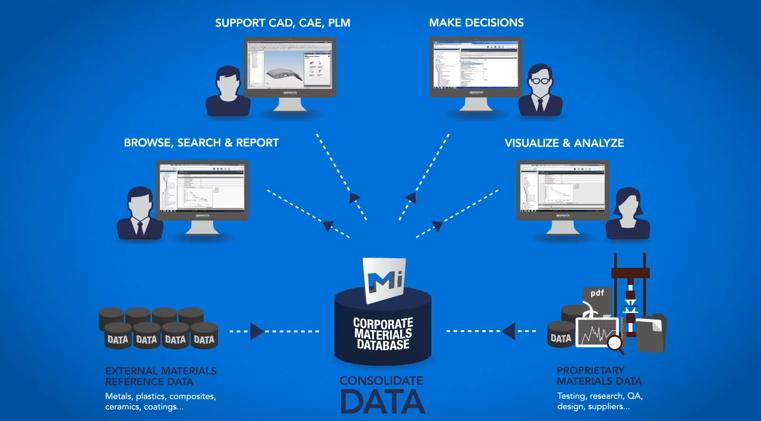Additive manufacturing requires software solutions to overcome the often and complex data challenges involved in developing additively made parts. Now Granta – through their experience in a range of additive manufacturing projects which incorporate industry best practices in managing vital material and process information – has created “MI:Additive Manufacturing,” a single system based on GRANTA MI materials information management software.
 GRANTA MI captures all relevant data, links it, makes it available to any appropriately-authorized user, and ensures full traceability. Granta was a major participant in the AMAZE project – a multinational collaboration by 28 corporations and research institutions focused on developing the rapid production of large, additively-manufactured metallic components.
GRANTA MI captures all relevant data, links it, makes it available to any appropriately-authorized user, and ensures full traceability. Granta was a major participant in the AMAZE project – a multinational collaboration by 28 corporations and research institutions focused on developing the rapid production of large, additively-manufactured metallic components.
“MI:Additive Manufacturing combines our core strength in materials information management with practical knowledge of Additive Manufacturing data gained from our collaborative projects, and work with some of our leading customers,” says Dr Patrick Coulter, chief operating officer at Granta Design. “The great news is that this will allow us to help many other customers who have expressed an interest in Additive Manufacturing, and have been asking us for a solution to manage their data in this area.”
 Granta technology captures and securely shares knowledge on materials, processes, and properties. This enables efficient comparison of data, improvement of production knowledge, refinement of processes, integration of simulation activities, and improved coordination of the R&D program.
Granta technology captures and securely shares knowledge on materials, processes, and properties. This enables efficient comparison of data, improvement of production knowledge, refinement of processes, integration of simulation activities, and improved coordination of the R&D program.
Now they say MI:Additive Manufacturing helps engineering enterprises by protecting their investment and intellectual property in AM research, builds an in-depth knowledge-base, significantly reduces time-to-market by avoiding wasted effort and supports the qualification and certification of additively-manufactured parts.
The AM process generates enormous amounts of data about the structure, properties and processing of the materials involved, and until the advent of MI:Additive Manufacturing, an easy-to-implement system to capture data and integrate it has been lacking. This new software aims to connect materials suppliers, R&D, part design, simulation and production elements in a seamless manner.
 Granta says it works like this. A typical workflow using MI:Additive Manufacturing starts with the importation of ‘logfiles’ from various AM machines. The system automatically stores process parameters, extracts logged data for specific builds, links the information to supplier data on the batches of material used, and captures testing and inspection results.
Granta says it works like this. A typical workflow using MI:Additive Manufacturing starts with the importation of ‘logfiles’ from various AM machines. The system automatically stores process parameters, extracts logged data for specific builds, links the information to supplier data on the batches of material used, and captures testing and inspection results.
Coulter says the data can feed into statistical analysis to determine mechanical properties which can be exported to simulation codes and used in optimizing part design and production. He says MI:Additive Manufacturing improves efficiency for many of the individual tasks in AM processes and research, and supports collaboration, sharing knowledge and increasing effectiveness across a whole program.
The heart of the system is what Granta calls a ‘schema’ which is used to define the types of data to be captured in the system, their inter-relationships, and how they might be processed.
Granta develops software for managing materials and process information in engineering enterprises and they serve sectors from aerospace, defense, energy, medical devices, automotive, motorsports, industrial equipment, materials production and publishing.
Have you ever worked with high-end manufacturing software like MI:Additive Manufacturing? Tell us about your experience in the MI:Additive Manufacturing Software forum thread on 3DPB.com.
Subscribe to Our Email Newsletter
Stay up-to-date on all the latest news from the 3D printing industry and receive information and offers from third party vendors.
You May Also Like
Hyliion CEO Thomas Healy on 3D Printing’s Role in the KARNO Generator
While the electric vehicle (EV) market faces an uncertain future, there’s no uncertainty about the fact that greenhouse gas emissions are drastically changing the climate on Earth. Thanks to its...
Attending the ASTM F42/ISO TC 261 Meetings: The Nitty-Gritty of Additive Manufacturing
I never thought I’d be so excited about an event focused on additive manufacturing (AM) standards, but here we are! When I learned that the recent biannual ASTM F42/ISO TC...
World’s Largest Polymer 3D Printer Unveiled by UMaine: Houses, Tools, Boats to Come
The University of Maine has once again broken its own record by unveiling the largest polymer 3D printer in the world. Surpassing its 2019 achievement, the new Factory of the...
Gorilla Sports GE’s First 3D Printed Titanium Cast
How do you help a gorilla with a broken arm? Sounds like the start of a bad joke a zookeeper might tell, but it’s an actual dilemma recently faced by...






























